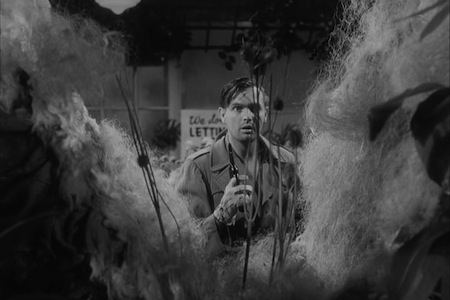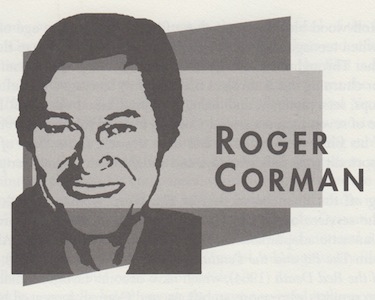Born: April 5, 1926, Los Angeles, CA
He gave me and a lot of others a chance.
—Francis Ford Coppola
Stanford graduate Roger Corman went to Hollywood in 1947 and endured a menial job as a messenger boy until his script for The Monster from the Ocean Floor (1954) came to life under his own direction and under a distribution deal that gave Corman a solid start; American International Pictures loaned him the money to make movies that he felt were marketable. This advantageous agreement was perfect for Roger Corman, who would use his intuition and business prowess to become a powerful producer in Hollywood by specializing in B movies. Throughout his illustrious career, Corman has been responsible for bringing some of the worst films and the finest talent to the big screen.
By 1955, Corman had a method that countered Hollywood’s traditional principiles: take chances on new actors, unusual stories and cheesy special effects. While other were praying for huge profits on a few blockbusters, he was content to nurture hundreds of thin budgets of less than $100,000 into highly successful films with lurid titles like Swamp Women (1955), Attack of the Crab Monsters (1957), She Gods of Shark Reef (1958) and Teenage Caveman (1958). These exploitation films found a home in one of the only areas where Hollywood was seeing substantial growth—the drive-in movie theaters.
Though Hollywood has a long history of manufacturing B movies—the name given to cinematic retreads that are released close on the heels of popular Hollywood blockbusters—these films thrived in the age of drive-in theaters, when teenage audiences were more interested in cheap thrills than in art films. Throughout the fifties, Corman developed an assembly-line process for churning out B thrillers that blatantly leveraged the leftover costumes, props, sets, plotlines and dialogue of established successes. Releasing an average of seven pictures a year, Corman learned to shoot extremely fast; several of his films were made in less than a week. Little Shop of Horrors (1960) reportedly took only two days and a night from original script to final print.
Coming off the financial success of The Wasp Woman (1960), Corman secured the services of veteran horror actor Vincent Price and produced a series of fantastic adaptations from the classic works of Edgar Allan Poe, among them The Pit and the Pendulum (1961), The Raven (1963) and The Masque of Red Death (1964), which have become favorites among horror fans. These projects were more ambitious, and Corman increased his spending on them, but the low-budget discipline was ever-present: while filming House of Usher (1960), Corman heard a report of a burning house and quickly gathered a camera crew to shoot some footage.
As the viewing habits of filmlovers ebbed and flowed, so did Corman themes. In the sixties, he focused on young hippies with a string of films featuring graphic violence and drug references. Some attempts—The Wild Angels (1966) and The Trip (1967), for instance—were more originaly then most (He was offered a chance to produce the phenomenal hit Easy Rider (1969) but turned it down).
The discovery of bright young talent became a Corman trademark. He scouted a fresh crop of college students with his keen eye for talent and gave early opportunities to a stellar group of today’s top filmmakers: Francis Ford Coppola, Peter Bogdanovich, Jonathan Kaplan, Jonathan Demme, Paul Bartel, John Sayles, James Cameron, Joe Dante, Ron Howard and Martin Scorsese. The actors he took chances on included eventual superstars as well. Jack Nicholson made his debut in Little Shop of Horrors; stars like Robert De Niro, Charles Bronson, Sylvester Stallone, Dennis Hopper, Peter Fonda, Barbara Hershey and Bill Paxton also graduated from the “Roger Corman School of Film.” Even more impressive is the distinguished list of directors whose films the dynamic Corman imported and distributed in art houses: François Truffaut, Ingmar Bergman and Federico Fellini found the “king of the B’s” willing to distribute their films in the United States.
Another important contribution to the industry was Corman’s success with overseas distribution. As second-run theaters and drive-ins diminished in number, he discovered that the revenue of his B films could be greatly increased by selling them internationally. In many cases, he made arrangements to sell the rights to distribute a film before shooting had commenced—an incredible testament to the track record of the legendary producer. Corman’s deft understanding of foreign markets and videocassette sales continues to perpetuate his legendary success in the film industry. He claims he has never lost money on a film, and his method was the subject of his book How I Made a Hundred Movies in Hollywood and Never Lost a Dime (1990). In fact, fewer than half of Roger Corman’s movies actually turned a profit, but the receipts do nothing to dim a sparkling career.
Corman stopped directing in 1971 and gave his full attention to production and distribution through his companies, variously named over the years but most recognized as New World. He sold his independent studio in 1983 for nearly $17 million and founded a new one immediately. Operating outside the studio system, Corman has become a legendary financier and a master of distribution. He follows a sound business model, making twenty films a year, which collect roughly $94 million worldwide.
Corman is perennially listed among the most powerful influencers in Hollywood despite his reputation as a schlock broker. He possesses a keen sense of which stories will entice film fans, a talent that has become vital for the contemporary producer. His mastery of the low-budget production has had a tremendous impact on independent filmmakers, documentarians and studios alike. His creative approach to marketing films has illuminated the lucrative opportunities for B movies in foreign markets and videocassette sales; one result has been the massive influx of films that circumvent traditional theater distribution and head straight to video stores. Finally, he has provided an alternative industry of films where fledgling directors and actors can break into mainstream moviemaking. Roger Corman has established himself as a savvy film producer whose secondhand films continue to give audiences a first look at fresh faces of tomorrow.
To read all the republished articles from ‘The Film 100,’ go to Reintroducing the Film 100 here on Keyframe.





